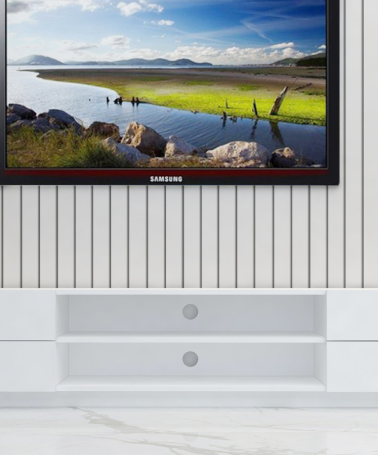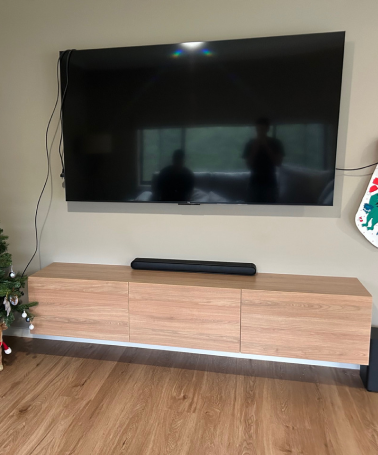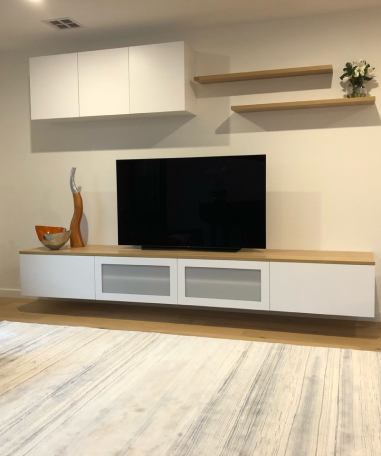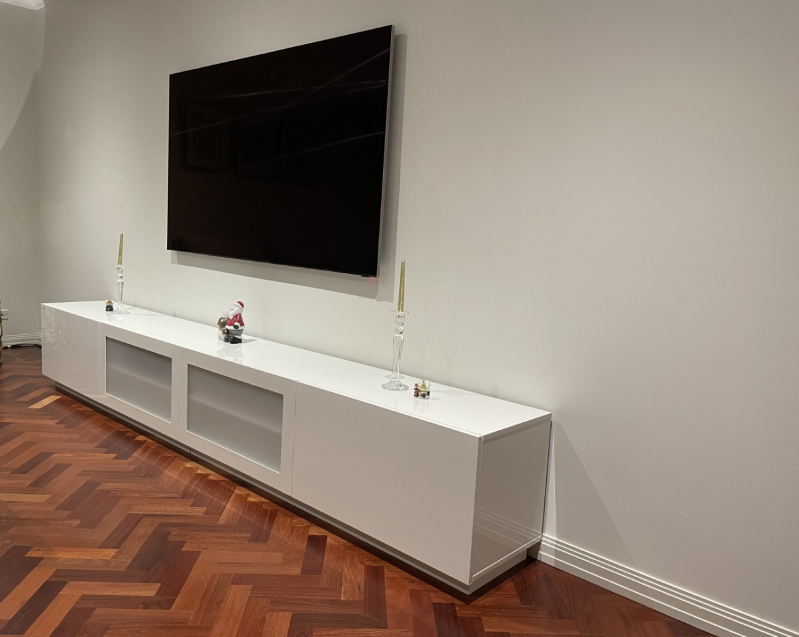How to Measure Your Space for a Large TV Unit
2nd Jan 2025
When it comes to choosing the perfect large TV unit for your home, accurate measurements are essential. Not only do you want the unit to fit perfectly in your space, but you also need it to enhance the overall look and functionality of your living room or entertainment area. Whether you're upgrading your entertainment setup or furnishing a new room, this guide will help you measure for a large TV unit with confidence.
At Just Modern Furniture, we offer Australian-made TV units designed to suit various styles and spaces. Let’s walk through how to measure your space effectively to ensure your new TV unit fits seamlessly into your home.
1. Assessing Your Available Space
Before you even pick up a measuring tape, take a step back and assess the layout of your room. The location of your TV unit is just as important as the size.
How to Determine the Ideal Location for Your TV Unit
Choose a spot that provides an optimal viewing angle for everyone in the room. Keep in mind the height of your TV and the distance from the seating area. Typically, the ideal viewing height for a TV is at eye level when sitting comfortably, so you might need to adjust the position of your TV unit accordingly.
Also, consider the layout and flow of the room. Ensure that placing the TV unit in a particular location won't obstruct pathways or hinder movement around the space. Avoid putting the unit in direct sunlight or near sources of heat, as these can affect your electronics.
2. Measuring the Width of Your Space
Now that you’ve chosen the perfect location, it’s time to measure the width of the space where your large TV unit will go.
How to Accurately Measure the Width for a Large TV Unit
To measure the width, start by using a tape measure to determine the distance from one side of the wall or furniture to the other. Measure the length where you plan to place the TV unit, ensuring that there is enough room not only for the TV unit itself but also for any additional components such as sound systems or consoles.
Make sure to account for a few extra centimeters on each side of the TV unit to allow for ventilation and ease of access. For example, if your TV unit is 180 cm wide, measure at least 200 cm of available space.
Accounting for Surrounding Furniture and Wall Space
While measuring, keep in mind the surrounding furniture. If there are side tables, armchairs, or other pieces of furniture nearby, ensure there is enough room for movement and that the TV unit doesn’t crowd the area. Also, consider the space between your TV unit and the wall—leaving a few centimeters on each side ensures proper ventilation for the TV and any other electronics.
3. Measuring the Height of the Space
The height of your TV unit will significantly affect the viewing experience. You want your TV to be at eye level when sitting down.
Finding the Right Height for Viewing Comfort
To measure the height, first, sit comfortably on your couch or chair and estimate the height of your eyes when looking at the TV. Then, measure from the floor to this height. The TV unit should align with this viewing height, ensuring a comfortable viewing angle.
If your unit has additional storage or a large base, make sure that it doesn’t place the TV too high or low for comfortable viewing. A large TV unit should balance aesthetics with practicality.
How High Should Your TV Unit Be for Optimal Viewing?
Generally, the TV unit should be about 40-60 cm high for most viewing situations. However, this measurement can vary depending on the size of the TV and the distance between the seating and the unit. For larger TVs, a taller unit may be required to accommodate the screen’s height.
4. Determining the Depth of Your TV Unit
The depth of the TV unit is just as important as the width and height. It ensures that the unit doesn’t stick out too far into the room while still providing enough space for all your entertainment equipment.
Understanding the Ideal Depth for a Large TV Unit
The ideal depth of a large TV unit is typically between 40-50 cm. This allows for enough space for your TV and any additional components such as DVD players, gaming consoles, or cable boxes.
It’s crucial to ensure that the depth complements the room’s dimensions—too deep, and it might overwhelm the space, while too shallow, and it may not provide enough storage or functionality.
Ensuring There’s Enough Space for Cable Management and Ventilation
Consider the depth of the TV unit with regards to cable management and ventilation. Most TV units come with built-in cable holes or cut-outs in the back to help organize wires and maintain airflow. Make sure that your chosen unit has these features if you plan to store your electronics in the unit.
5. Accounting for Extra Storage Needs
A large TV unit isn't just about holding your TV—it's also about storage. Whether you need extra space for gaming consoles, DVDs, or remote controls, measuring for storage is an essential part of selecting the right unit.
How to Measure for Storage Space in Your TV Unit
If you plan to use the TV unit for additional storage, like drawers or shelves for media components, it’s important to measure the space you need. Consider the height, width, and depth of the items you want to store. For example, gaming consoles or DVD players typically need around 40 cm in height and about 30 cm in depth, so make sure your unit can accommodate these sizes.
Considering Shelves, Cabinets, and Drawers for Added Functionality
When selecting your large TV unit, look for one that offers a good combination of open shelving for easy access and closed cabinets or drawers for hidden storage. This flexibility helps keep your space neat while giving you a place to store remotes, cables, or entertainment devices.
6. Leave Room for Air Circulation and Safety
It's easy to overlook the importance of ventilation, but it's essential to ensure your electronics stay cool and function properly.
Why Ventilation and Air Circulation Are Important for Large TV Units
When measuring for your TV unit, ensure there’s enough room for air circulation, especially around the back of the unit where electronics are stored. Good airflow helps prevent overheating, which can damage your devices over time.
Ensuring Safety for Your TV and Surrounding Area
If you have children or pets, it’s crucial to make sure your TV unit is stable and secure. Consider anchoring the unit to the wall or selecting a design that’s stable and unlikely to tip over.
Conclusion
By accurately measuring your space for a large TV unit, you’ll be able to select a unit that enhances your living room while offering the perfect combination of size, style, and functionality. At Just Modern Furniture, we offer a wide range of Australian-made TV units that are built to fit your home perfectly, no matter the size or layout. Shop now to find the perfect TV unit for your space and create the ultimate entertainment setup.
FAQs
1. How do I know if a TV unit is too large for my space?
Measure the width, height, and depth of the area where you want to place the unit. If the TV unit leaves enough room for comfortable viewing and movement, it should fit well.
2. Should I leave space between my TV unit and the wall?
Yes, leave a few centimeters between the unit and the wall for ventilation and cable management. This ensures your devices remain cool and function properly.
3. How can I fit a large TV unit in a small room?
Choose a TV unit with a compact depth or opt for wall-mounted units. You can also explore customizable TV units that are tailored to your specific space.
4. Can I get a custom-sized TV unit?
Yes! Just Modern Furniture offers customizable options to help you find the perfect fit for your space. Contact us to discuss your size and design preferences.

 Search entire store here...
Search entire store here...




















